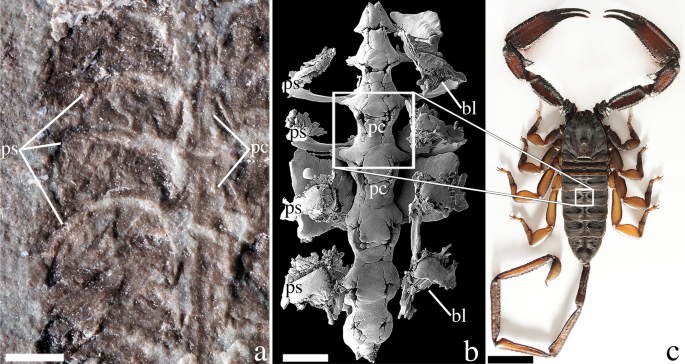
Found near Waukesha, Wisconsin:
Today in Scientific Reports, paleontologists announce the discovery of the oldest known scorpions to date: a pristinely preserved pair of 437-million-year-old fossils, complete with what seem to be venom-packed tails.
The dangerous-looking duo, newly christened Parioscorpio venator, bear a remarkable resemblance to modern species, showing scorpions hit upon a successful survival strategy early in their evolution, says study author Andrew Wendruff, a paleontologist at Otterbein University …
Together with other, younger fossils from the same geologic period, the ancient arachnids suggest that scorpions have looked and acted in much the same way ever since they first appeared on Earth…
“The amazing preservation of the internal anatomy … reiterates how the [scorpion] ground plan has stayed the same, not just on the outside, but the inside, too,” says Lorenzo Prendini, a scorpion evolution expert at the American Museum of Natural History who helped uncover another batch of Silurian fossils from this lineage, but wasn’t involved in the new study.
Katherine J. Wu, “World’s Oldest Scorpions May Have Moved From Sea to Land 437 Million Years Ago” at Smithsonian Magazine
It doesn’t sound as though they bothered with much evolution. How would we distinguish their origin from creation? At a certain point, does evolution become creation? Just wondering.
It’s not clear how committed these scorpions were to living on land but apart from that …
“Anything that pushes the origins of arachnids back further is significant,” wrote paleontologist Jason Dunlop, curator of arachnids at Berlin’s Natural History Museum, in an email to Science. That’s because arachnids are the second most diverse group of animals after insects, and thus could shed light on the origin of spiders, ticks, mites, and modern-day scorpions …
The scientists also noted that the internal anatomy of the ancient animals was well preserved, which is rare for fossils of this age. When they compared the anatomy of the two fossils to modern-day scorpions, they found striking similarities in the circulatory and respiratory structures. “This suggests that parts of the internal anatomy of scorpions have not changed much in nearly 440 million years,” Dunlop says. The researchers know the ages of fossils ages thanks to other well-dated animal fossils at the site.
Rodrigo Pérez Ortega, “This is the oldest scorpion known to science” at Science
Paper. (open access)
See also: Half-Billion-Year-Old Predator Is The Mother Of All Spiders?
and
Stasis: Life goes on but evolution does not happen